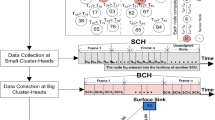Abstract
In a wireless sensor-actuator network, sensor nodes gather information on the physical world and can deliver messages with sensed values to only nearby nodes due to weak radio. Thus, messages sent by nodes might be lost due to not only collision but also noise. Messages are forwarded by sensor nodes to an actuator node. In the redundant data transmission (RT) protocol, a sensor node sends a message with not only its sensed value but also sensed values received from other sensor nodes. Even if a message with a sensed value v is lost, an actuator node can receive the value v from a message sent by another sensor node. In addition, we have to reduce the energy consumption of a sensor node. A sensor node mainly consumes the energy to send and receive messages. Even if an event occurs, only some number of sensor nodes sensing the event send the sensed values to reduce the total energy consumption. We discuss an energy-efficient data transmission protocol. We evaluate the RT protocol compared with the CSMA protocol in terms of how much sensing data a node can receive in presence of messages loss. We evaluate the RT protocol in terms of how many number of sensed values an actuator node can receive in presence of message loss. We show that about 72% of sensed values can be delivered to an actuator node even if 95% of messages are lost due to noise and collision.
Similar content being viewed by others
References
Akyildiz, I. F., & Kasimoglu, I. H. (2004). Wireless sensor and actor networks: research challenges. Ad Hoc Networks Journal, 2, 351–367.
Akyildiz, I. F., Su, W., Sankarasubramaniam, Y., & Cayirci, E. (2002). Wireless sensor networks: a survey. Computer Networks Journal, 38, 393–422.
Chang, Y.-L., & Shen, S. (1987). Design of priority schemes in csma/cd local are networks. In Proceedings of the 20th annual symposium on simulation (ANSS’87) (pp. 45–64).
Chen, Y., Smavatkul, N., & Emeott, S. (2004). Power management for VoIP over ieee 802.11 WLAN. In IEEE wireless communications and networking conference (Vol. 3, pp. 1646–1653).
Crossbow Technology (2006). Inc. MPR2400J/420/520 MIB user’s manual, 2006.
Durresi, A., & Paruchuri, V. (2005). Geometric broadcast protocol for heterogeneous sensor networks. In Proc. of 19th IEEE international conf. on advanced information networking and applications (AINA2005) (Vol. 1, pp. 343–348).
Gay, D., Levis, P., von Behren, R., Welsh, M., Brewer, E., & Culler, D. (2003). The nesc language: A holistic approach to networked embedded systems. In Proc. of the ACM SIGPLAN 2003 conference on programming language design and implementation (PLDI’03) (pp. 1–11).
Han, C.-C., Kumar, R., Shea, R., Kohler, E., & Srivastava, M. (2005). A dynamic operating system for sensor nodes. In Proc. of the 3rd international conference on mobile systems, applications, and services (pp. 163–176).
Joe, I., & Batsell, S. G. (2000). Reservation csma/ca for multimedia traffic over mobile ad-hoc networks. In IEEE international conference on communications (Vol. 3, pp. 1714–1718).
Postel, J. (1981). Transmission control protocol RFC 793.
Levis, P., Lee, N., Welsh, W., & Culler, D. (2003). Tossim: accurate and scalable simulation of entire tinyos applications. In Proceedings of the 1st international conference on embedded networked sensor systems (pp. 126–137).
Lin, T.-H., Chen, Y.-S., & Lee, S. (2004). Pcar: a power-aware chessboard-based adaptive routing protocol for wireless sensor networks. In Emerging technologies: frontiers of mobile and wireless communication, 2004. Proceedings of the IEEE 6th circuits and systems symposium (Vol. 1, pp. 145–148).
Paruchuri, V., Durresi, A., & Barolli, L. (2005). Energy aware routing protocol for heterogeneous wireless sensor networks. In Proc. of 16th international workshop on network-based information systems (NBiS2005) (pp. 133–137).
Paruchuri, V., Durresi, A., Barolli, L., & Takizawa, M. (2007). Three dimensional broadcast protocol for wireless networks. In Proc. of the 36th international conference on parallel processing (ICPP2007) (pp. 10–14).
Schurgers, C., Srivastava, M. B., & Tsiatsis, V. (2002). Stem: topology management for energy-efficient sensor networks. In Proceedings of IEEE aerospace conference proceedings (Vol. 3, pp. 1099–1108).
Yao, Z., Fan, P., & Cao, Z. (2004). An enhanced csma-ca mechanism for multihop ad hoc networks. In Communications, 2004 and the 5th international symposium on multi-dimensional mobile communications proceedings (Vol. 2, pp. 966–970).
Zhang, J., Huang, B., Tu, L., & Zhang, F. (2005). An energy-efficient cross-layer scheduling for clustered sensor networks. In IEEE international symposium on communication and information technologies 2005 (ISCIT2005) (Vol. 1, pp. 238–241).
Author information
Authors and Affiliations
Corresponding author
Rights and permissions
About this article
Cite this article
Morita, K., Aikebaier, A., Enokido, T. et al. A data transmission protocol for reliable and energy-efficient data transmission in a wireless sensor-actuator network. Telecommun Syst 38, 71–82 (2008). https://doi.org/10.1007/s11235-008-9096-y
Published:
Issue Date:
DOI: https://doi.org/10.1007/s11235-008-9096-y




